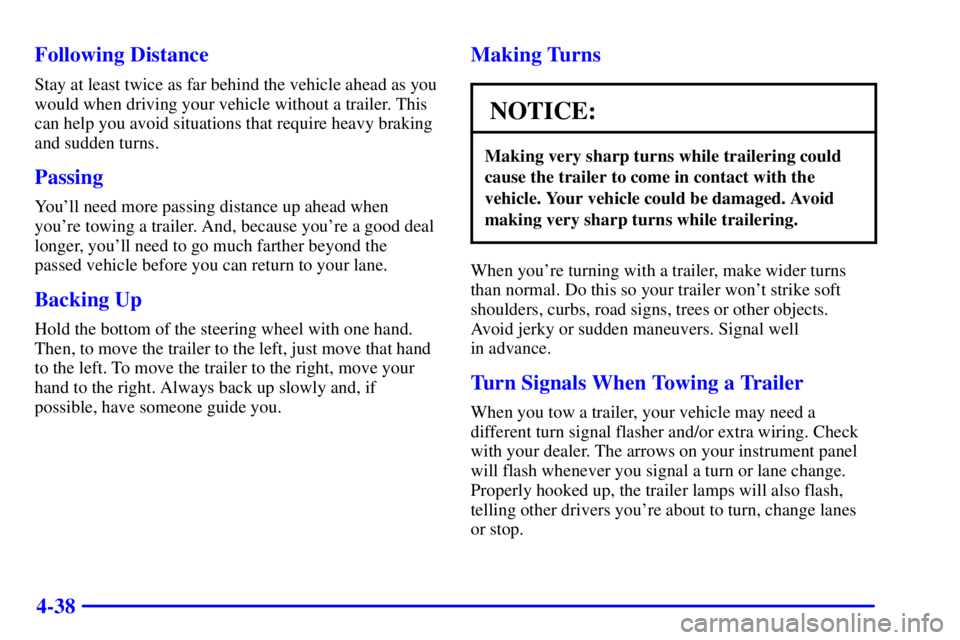Page 218 of 392

4-23
The most important advice on freeway driving is: Keep
up with traffic and keep to the right. Drive at the same
speed most of the other drivers are driving. Too
-fast or
too
-slow driving breaks a smooth traffic flow. Treat the
left lane on a freeway as a passing lane.
At the entrance, there is usually a ramp that leads to the
freeway. If you have a clear view of the freeway as you
drive along the entrance ramp, you should begin to
check traffic. Try to determine where you expect to
blend with the flow. Try to merge into the gap at close to
the prevailing speed. Switch on your turn signal, check
your mirrors and glance over your shoulder as often as
necessary. Try to blend smoothly with the traffic flow.
Once you are on the freeway, adjust your speed to the
posted limit or to the prevailing rate if it's slower. Stay
in the right lane unless you want to pass.
Before changing lanes, check your mirrors. Then use
your turn signal.Just before you leave the lane, glance quickly over your
shoulder to make sure there isn't another vehicle in your
ªblindº spot.
Once you are moving on the freeway, make certain you
allow a reasonable following distance. Expect to move
slightly slower at night.
When you want to leave the freeway, move to the proper
lane well in advance. If you miss your exit, do not,
under any circumstances, stop and back up. Drive on to
the next exit.
The exit ramp can be curved, sometimes quite sharply.
The exit speed is usually posted.
Reduce your speed according to your speedometer, not
to your sense of motion. After driving for any distance
at higher speeds, you may tend to think you are going
slower than you actually are.
Page 233 of 392

4-38 Following Distance
Stay at least twice as far behind the vehicle ahead as you
would when driving your vehicle without a trailer. This
can help you avoid situations that require heavy braking
and sudden turns.
Passing
You'll need more passing distance up ahead when
you're towing a trailer. And, because you're a good deal
longer, you'll need to go much farther beyond the
passed vehicle before you can return to your lane.
Backing Up
Hold the bottom of the steering wheel with one hand.
Then, to move the trailer to the left, just move that hand
to the left. To move the trailer to the right, move your
hand to the right. Always back up slowly and, if
possible, have someone guide you.
Making Turns
NOTICE:
Making very sharp turns while trailering could
cause the trailer to come in contact with the
vehicle. Your vehicle could be damaged. Avoid
making very sharp turns while trailering.
When you're turning with a trailer, make wider turns
than normal. Do this so your trailer won't strike soft
shoulders, curbs, road signs, trees or other objects.
Avoid jerky or sudden maneuvers. Signal well
in advance.
Turn Signals When Towing a Trailer
When you tow a trailer, your vehicle may need a
different turn signal flasher and/or extra wiring. Check
with your dealer. The arrows on your instrument panel
will flash whenever you signal a turn or lane change.
Properly hooked up, the trailer lamps will also flash,
telling other drivers you're about to turn, change lanes
or stop.
Page 234 of 392

4-39
When towing a trailer, the arrows on your instrument
panel will flash for turns even if the bulbs on the trailer
are burned out. Thus, you may think drivers behind you
are seeing your signal when they are not. It's important
to check occasionally to be sure the trailer bulbs are
still working.
Your vehicle has bulb warning lights. When you plug
a trailer lighting system into your vehicle's lighting
system, its bulb warning lights may not let you know if
one of your lamps goes out. So, when you have a trailer
lighting system plugged in, be sure to check your
vehicle and trailer lamps from time to time to be sure
they're all working. Once you disconnect the trailer
lamps, the bulb warning lights again can tell you if one
of your vehicle lamps is out.
Driving On Grades
Reduce speed and shift to a lower gear before you start
down a long or steep downgrade. If you don't shift
down, you might have to use your brakes so much that
they would get hot and no longer work well.
On a long uphill grade, shift down to THIRD (3)
and reduce your speed to around 45 mph (70 km/h)
to reduce the possibility of engine and
transaxle overheating.
Parking on Hills
CAUTION:
You really should not park your vehicle, with a
trailer attached, on a hill. If something goes
wrong, your rig could start to move. People can
be injured, and both your vehicle and the trailer
can be damaged.
But if you ever have to park your rig on a hill, here's
how to do it:
1. Apply your regular brakes, but don't shift into
PARK (P) yet.
2. Have someone place chocks under the trailer wheels.
3. When the wheel chocks are in place, release the
regular brakes until the chocks absorb the load.
4. Reapply the regular brakes. Then apply your parking
brake, and then shift to PARK (P).
5. Release the regular brakes.
Page 237 of 392
5-2
Hazard Warning Flashers
Your hazard warning flashers let you warn others. They
also let police know you have a problem. Your front and
rear turn signal lamps will flash on and off.
Press down on the button
located on top of the
steering column to make
your front and rear turn
signal lamps flash on
and off.
Your hazard warning flashers work no matter what
position your key is in, and even if the key isn't in.
To turn off the flashers, press down on the button again.
When the hazard warning flashers are on, your turn
signals won't work.
Other Warning Devices
If you carry reflective triangles, you can set one up at
the side of the road about 300 feet (100 m) behind
your vehicle.
Page 301 of 392
6-39
1. Turn the horizontal
aiming screw (A)
until the
indicator (B) is
lined up with zero.
2. Turn the vertical aiming screw (C) until the level
bubble (D) is lined up with zero.
Front Turn Signal
The front turn signal bulbs can be accessed by removing
the headlamp assembly as described in the previous bulb
replacement procedure.
Once the headlamp
assembly has been removed,
reach down from the top of
the vehicle and, while
pressing the lock tab on the
socket, turn the socket
one
-quarter of a turn and
pull it out.
Remove the old bulb by pulling it straight out of the
socket. Replace the bulb and turn the bulb assembly
back into place.
Page 302 of 392
6-40 Rear Turn Signal/Stoplamp
1. Open the trunk. On either side of the rear of the
trunk is a plastic retainer that holds the cargo net and
taillamp assembly in place.
2. Unhook the cargo net
from the cargo net
retainer and remove
the retainer by turning
it counterclockwise.
3. Remove the plastic retaining screws on the
trunk's interior.
4. Pull back the trunk trim panel.
5. Beneath the trim panel are three nuts that secure
the taillamp assembly. Remove these nuts with a
10 mm wrench. Remove the nuts from only the side
you want to access. The turn signal and a stoplamp
can now be accessed.
Page 304 of 392
6-42 Rear Turn Signals/Stoplamps/
Back-Up Lamps
The turn lamps, stoplamps and back-up bulbs are
located behind the taillamp assembly along the trunk lid.
The following instructions explain how to access
these bulbs.
1. There are four studs
located at the edge of the
trunk lid. Remove the
protective vinyl caps
from the studs.
2. Use a 10 mm wrench to remove the nuts from
the studs.
Page 331 of 392
6-69
Fuse Usage
LP PK L Underhood Lamp, L PK/
Sidemarker, L Park/Turn Lamp,
SBM, L Tail Signal Lamp,
L Tail/Stop Lamp,
L Rear Sidemarker
LP PK R Rt Pk/Sidemarker Lamp,
Rt PK/Turn Lamp, Rt Tail/Sign
Lamp, Rt Tail/Stoplamp, Rt Rear
Sidemarker, Stop/Tail Lamp,
Tail/Signal Lamp, License
Lamp, RFA
RUN Run/Accessory
WSW Wiper Motor
EMPTY Not Used
WSW/RFA Wiper Switch, RFA, Rain Sense
B/U LP
EC Mirror, Back
-Up LampsUnderhood Fuse Block
There are additional fuses located on the passenger's
side of the engine compartment.
Minifuses Usage
1 Air Sol
2 SBM, LCM
3 Turn Signal
Page:
< prev 1-8 9-16 17-24